
Zoom License Cost 2026: Which Plan Offers the Best Value for Your…
Table of Contents ToggleShelfware DefinedWhy Shelfware HappensPoor Organizational OversightShadow IT and...
Back
Back
Search for Keywords...
Blog

Table of Contents
“Shelfware” is a term for software that an organization purchases, then fails to use or underutilizes. These tools sit on the shelf, wasting money and complicating operations without delivering value.
Neglected licenses and apps are not uncommon in modern SaaS inventories. Our data shows that businesses now average more than 275 SaaS applications in their portfolios—a 2.2% increase from the year prior (269).
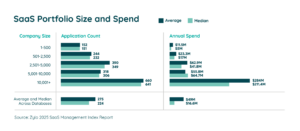
Despite this growth, software usage is not keeping pace. On average, 53% of all SaaS licenses remain either unused or not used often enough to warrant spending. As such, over half of all licensed software contributes little to nothing to organizational outcomes.
In its simplest terms, shelfware is any sort of software that’s been paid for but not used. This could result from poor adoption, overlooked renewals, or redundant functionality.
Being aware of what shelfware is helps reveal why it’s so damaging. It inflates software costs, introduces unnecessary security risks, and creates drag across departments. It also threatens confidence in technology investments, especially when leadership assumes a tool delivers ROI based on procurement alone.
Shelfware accumulation is often due to fast growth, decentralized decision-making, and changing tech needs that are not being met. Several causes contribute to shelfware issues in companies of all sizes.
For example:
IT now controls just 26% of SaaS spend and 16% of app ownership, according to our data, leaving the majority of purchasing and management decisions scattered across departments.

This lack of centralized oversight creates major visibility gaps that make it easy for tools to be forgotten, especially if they were intended for short-term use. Without formal deprovisioning or license reclamation processes, unused licenses accumulate. Renewals become reactive, and redundant or inefficient systems persist without clear accountability.
When departments purchase tools outside of formal procurement or IT processes, it’s known as shadow IT. It’s a major driver of shelfware, according to the SaaS Management Index, which found that departments outside of IT are responsible for almost three-quarters of SaaS application ownership.
Though decentralization enables speed and flexibility, it also leads to fragmented adoption, duplicated functions, and unused licenses. Without unified visibility, IT can’t ensure tools are secure, supported, or compliant. As a result, finance loses control over budget forecasting.
Renewals often happen automatically, without teams reviewing current usage or contract terms. This makes it easy for low-use or redundant apps to remain in the stack. Our data noted that 68% of SaaS licenses are renewed, but may be done with little to no usage review.
Other vendor management missteps that contribute to shelfware include:
These patterns tend to compound over time. One year of over-provisioning quickly becomes three years of excessive waste.
Even when tools are purchased for valid business reasons, companies often fail to track whether users actually adopt them. Without proper enablement, training, or onboarding, licenses may be active but functionally unused. This is especially common during periods of rapid growth, when tools are rolled out faster than employees can be onboarded. Without designated owners driving adoption, even the best platforms can turn into shelfware.
Organizations should also factor in change fatigue. When users are constantly asked to adopt new tools, they may ignore them in favor of what’s familiar. If employees don’t clearly understand a tool’s purpose or benefit, they’re much less likely to use it.
Shelfware affects various aspects of an organization’s operations, from finances to security posture and employee productivity.
Key impacts of shelfware include:
The most immediate consequence of shelfware is wasted spending. Our data shows that the average organization wastes $21M each year on unused SaaS licenses. That’s nearly half of the total license investment offering no return at all, including:
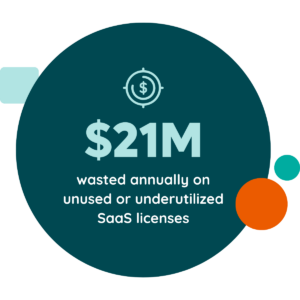 In categories like productivity, learning management, and communication, overspending on licenses is especially common. Without a license optimization strategy, this drain compounds quarter after quarter.
In categories like productivity, learning management, and communication, overspending on licenses is especially common. Without a license optimization strategy, this drain compounds quarter after quarter.
Additionally, shelfware often escapes budget scrutiny due to its decentralized nature. Departments renew their own tools before cross-checking with others, and costs stay buried in distributed P&Ls.
This financial waste also limits broader innovation efforts. When too much of the IT or procurement budget is tied up in unused tools, businesses may lack the flexibility to fund new initiatives, adopt emerging technologies, or support strategic innovation across the organization.
A cluttered tech stack filled with underused applications creates friction for both IT and employees. For one, IT teams need to support, secure, and provision tools that offer little to no business value. Employees deal with inefficiencies and decision fatigue when working with overlapping systems. Finally, business leaders lack clear views of which tools are actually improving performance.
This results in lower productivity, weaker alignment across teams, and a heavier administrative burden. In many cases, the projected functionality that SaaS promises is replaced with confusion and a lack of direction. Numerous tools with similar functions compete for use because no single, centralized source exists.
Over time, fragmented systems can reduce employee trust in the tools provided. Workers may become skeptical of new implementations or ignore them altogether, especially if they know the latest tools will be replaced within months.
Shelfware also brings about security and compliance risks. Dormant tools may still hold sensitive data or offer user access, which makes them vulnerable entry points. According to Netskope’s Cloud Confidence Index, many SaaS apps in use fall into the “Low” or “Poor” risk categories.
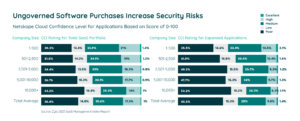
Unused applications that are never formally decommissioned create blind spots in an organization’s security perimeter. Further, this risk grows with each additional tool that’s licensed but unmanaged. Without a unified inventory of tools in use, it becomes incredibly difficult to conduct risk assessments, enforce access controls, or remain compliant with changing data privacy laws.
Security teams also need to handle permission sprawl, where users have access to dormant apps that have not yet been offboarded. These accounts are vulnerable to external threats as well as insider misuse.
When shelfware fills your software portfolio, it impairs visibility and complicates strategic planning. For example, leaders might assume adoption is high or tools are effective when, in fact, usage is low or nonexistent.
This misalignment affects:
It can also distort internal performance metrics. For example, a tool may show strong renewal rates as a result of auto-billing, not usage. Leadership may assume these programs are valuable when, in reality, engagement is negligible.
Inaccurate data also affects digital transformation initiatives. When decisions are based on faulty assumptions about tool usage, progress stalls, and transformation goals fall out of sync with employee workflows.
To effectively minimize shelfware, organizations first have to identify it. This involves understanding current tech stacks, usage patterns, and procurement processes. Here are some steps to help uncover shelfware in organizations:
A comprehensive audit of current SaaS tools is fundamental in any effective shelfware identification strategy. This means reviewing all licenses, both active and expired, and comparing them to actual usage. According to our data, 53% of SaaS licenses go unused or underused on average, so finding dormant software should be a priority.
Look for applications that:
This process will help identify software that’s either redundant, underutilized, or completely forgotten about. It’s also worth mapping usage to role requirements. If employees aren’t engaging with tools tied to their core workflows, it may point to misalignment.
Audits should also include a licensing and spending analysis. Even if a tool is only occasionally used, it may still be strategically valuable. This is especially so if it serves a specialized team or compliance need, so identifying these exceptions will help prevent over-pruning.
For each tool, gather data on active user engagement. Usage data can often be accessed directly through the application or via an integration with a SaaS Management Platform.
Track:
If a tool is only used sparingly or accessed by a small group, it may be a candidate for removal or consolidation. Feature-level insights are also helpful. Some platforms offer analytics dashboards that show engagement by either module or function, which makes it easier to pinpoint underused areas.
To better understand whether you are over-subscribed to certain tools, consider comparing usage patterns with industry benchmarks. According to the SaaS Management Index, many organizations waste significant sums of money on underused licenses.
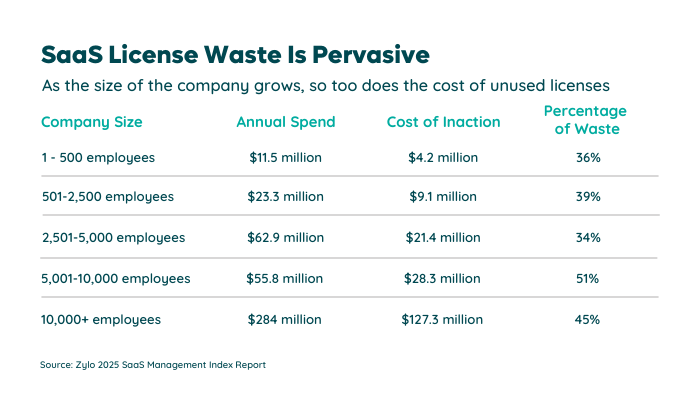
Benchmarking application usage against similar-sized organizations or those within your sector can help highlight inefficiencies in your software portfolio. It can also support business cases for renegotiation, consolidation, or cancellation during renewal cycles.
The rising popularity of shadow IT means it’s important to cross-check with team leads and department heads. Get their feedback on the tools currently in use. This may uncover additional shelfware that IT is unaware of or tools that departments no longer need but have never formally decommissioned. Including stakeholders in software assessments also encourages buy-in when it comes time to reduce or do away with redundant tools.
Once you’ve identified shelfware in your tech stack, the next step is to eliminate it and prevent future shelfware issues. This requires careful planning and implementation of processes that reduce the likelihood of shelfware accumulation in the future.
Before implementing new software, it’s important to lay the groundwork by taking the right pre-purchase steps. This ensures that the chosen tools meet your business needs and will be utilized effectively.
Before purchasing new software, conduct a detailed needs analysis to ensure the tool fits your organization’s needs. Collect input from end users, department leads, and IT teams to highlight current pain points. A collaborative approach helps ensure the chosen software aligns with real-world needs and reduces the risk of underutilization.
Schedule live demos with vendors to see the platform in action. Demos provide insight into user interface, integration capabilities, and feature usability. Through demos, teams can avoid investing in platforms that don’t meet real-world needs or end up underutilized.
Once the software has been purchased, it’s time to maximize its value through effective implementation efforts. The following steps ensure tools remain relevant within your organization.
To encourage software adoption, invest in structured user training post-purchase. Provide team members with onboarding sessions and offer ongoing resources (e.g., video tutorials, help docs, or live Q&A support). Assign internal experts who can guide others in using the platform effectively. Well-trained users are far more likely to use new tools, which reduces the risk of licenses going unused.
Set and review usage benchmarks regularly to ensure that SaaS software tools are delivering value and meeting business needs. For example, 90% utilization may be a healthy benchmark for a widely-used application like Google Workspace.
During these reviews, teams should:
With the majority of subscriptions being renewed, it’s important to implement regular reviews with clearly defined benchmarks. Then, it becomes easier to avoid paying for tools that aren’t being used effectively. Organizations may also choose to build review cycles into budgeting processes so that every renewal is based on financial oversight.
When negotiating SaaS contracts, always aim for flexibility. Long-term commitments without clear exit strategies can lead to waste if the software becomes unnecessary or underutilized. Always discuss co-termination or downgrade options with vendors to ensure you aren’t locked into unnecessary licenses.
When evaluating software renewals, look for opportunities to reduce the number of licenses, downgrade features, or move to a more suitable pricing model. Some vendors also offer consumption-based pricing or volume discounts, which may better match real-world usage patterns.
Governance around software acquisition, implementation, and ongoing use is essential to prevent shelfware.
The final phase in shelfware elimination is ensuring continuous management of your software tools. Establishing systems for regular monitoring can help businesses stay on top of evolving software needs.
Without centralized oversight, shelfware will accumulate. By assigning a dedicated team or individual to manage SaaS contracts, renewals, and deprovisioning, businesses can ensure that only essential tools remain in use.
A centralized management platform, like Zylo, can provide visibility into license usage, renewal dates, and contract terms. These platforms also highlight underused licenses, automate early renewal alerts, and consolidate vendor data.
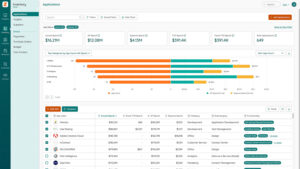
A culture of accountability helps ensure that tools are actively used or decommissioned promptly when they’re no longer needed. Teams are accountable for managing software usage for their apps to ensure adoption. And they understand new software purchases should match business needs.
Encourage accountability by:
To ensure accountability to remove shelfware, it requires visibility into usage, communicating clear expectations, and regular performance check-ins. By treating SaaS as a critical part of workflows, companies can build habits that promote proactive management for the long term.
Shelfware management requires continuous monitoring. As teams grow, shrink, or pivot, their software needs will change. To stay agile, organizations need to establish a clear process for evaluating their stack.
This may include monthly reports on license usage, biannual or quarterly stakeholder meetings to review tool appropriateness, and alerts when apps fall below defined engagement levels. Establishing these operational rhythms enables teams to spot shelfware trends long before waste accumulates.
Where possible, integrate SaaS usage data into broader business intelligence efforts. By correlating tool engagement with performance KPIs, organizations can more clearly see which platforms yield results and which drain resources.
Dashboards can help visualize SaaS performance and make shelfware easier to identify. Develop dashboards that show login frequency, feature adoption, license allocation, and renewal dates. When stakeholders have real-time visibility into usage trends, it becomes easier to spot dips in engagement and take action before further issues arise.
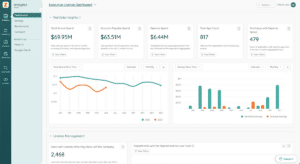
Shelfware continues to diminish software ROI, drain company budgets, and create unnecessary complexity in tech stacks. As organizations expand their SaaS portfolios, they must focus on visibility, usage tracking, and centralized management.
Regular audits, clear benchmarks, and flexible contracts help ensure tools align with business needs. Departments should be equipped and expected to monitor adoption and make adjustments as goals evolve.
Getting rid of shelfware is an ongoing discipline, but with the right processes, companies can maintain leaner stacks, improve performance, and make more informed technology decisions. Learn how Zylo’s solution can help, or request a demo to see it in action.

Table of Contents ToggleShelfware DefinedWhy Shelfware HappensPoor Organizational OversightShadow IT and...

Table of Contents ToggleShelfware DefinedWhy Shelfware HappensPoor Organizational OversightShadow IT and...

Table of Contents ToggleKey Themes That Shaped SaaS Management in 20251....

Table of Contents ToggleShelfware DefinedWhy Shelfware HappensPoor Organizational OversightShadow IT and...
| Cookie | Duration | Description |
|---|---|---|
| cookielawinfo-checkbox-analytics | 11 months | This cookie is set by GDPR Cookie Consent plugin. The cookie is used to store the user consent for the cookies in the category "Analytics". |
| cookielawinfo-checkbox-functional | 11 months | The cookie is set by GDPR cookie consent to record the user consent for the cookies in the category "Functional". |
| cookielawinfo-checkbox-necessary | 11 months | This cookie is set by GDPR Cookie Consent plugin. The cookies is used to store the user consent for the cookies in the category "Necessary". |
| cookielawinfo-checkbox-others | 11 months | This cookie is set by GDPR Cookie Consent plugin. The cookie is used to store the user consent for the cookies in the category "Other. |
| cookielawinfo-checkbox-performance | 11 months | This cookie is set by GDPR Cookie Consent plugin. The cookie is used to store the user consent for the cookies in the category "Performance". |
| viewed_cookie_policy | 11 months | The cookie is set by the GDPR Cookie Consent plugin and is used to store whether or not user has consented to the use of cookies. It does not store any personal data. |
